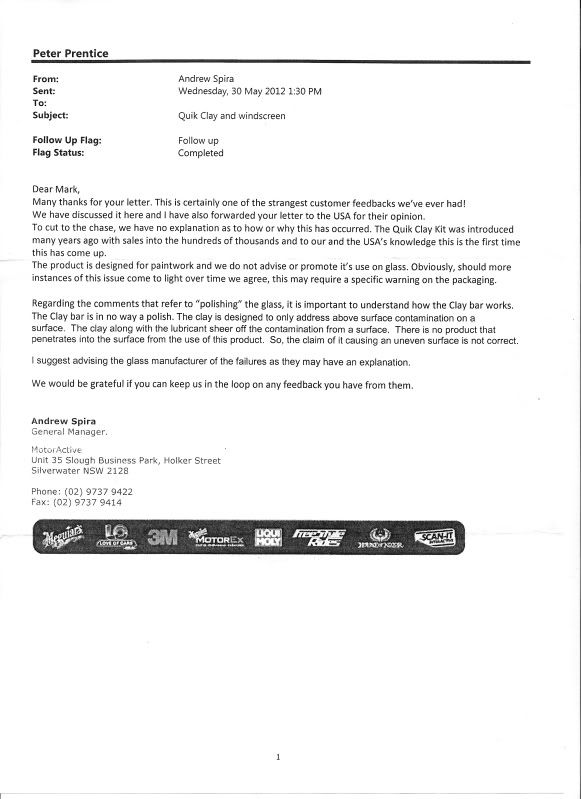Sent the following to Meguiars.
Dear Sir / Madam,
I regularly read posts made on the website:
http://www.fordforums.com.au where I was introduced to your Quik Clay product. There were a lot of positive reports on the product. Back in 2010 I bought one of your Quick Clay kits for use on my classic Mini. As reported on the web site I was very happy with the results on my paintwork. There were numerous reports about using the product on their windscreens to get them really clear. I used Meguiars Quik Clay on my windscreen following the instructions given. That day when I drove my Mini the windscreen shattered. I put a post up on the website asking if anyone else had experienced the same thing. I was told no, they have been using it for ages on their windscreens with no negative results. This past weekend I was preparing my Mini for a classic car show and thought maybe it was a coincidence so I used Meguiars Quik Clay on my windscreen again. Once again the results were good and my screen was very clear, but once again the first time I drove my car the windscreen shattered. After some research I found the following examination to why my screen shattered:
● Its because it is a toughened (not laminated) screen. Used on all Australian Minis except Cooper S (and maybe the GT) which were laminated. The surface of the glass is in compression, when you clay bar it the surface stress is released, so tinkle tinkle. You shouldn’t even polish marks out of these screens with glass polish I’ve been told.
Get a new laminated screen……
As there is no mention of any problems associated with the use of Meguiars Quik Clay on glass on the product packaging. It opened up a debate on the website about cars with laminated windscreens and toughened glass side windows, please see the following posts:
● It has to do with the surface tension of the toughened glass. Because the glass is baked again after cutting and shaping the surface shrinks thus compressing the internal structure of the glass and hardening it. When you clay bar it you essentially are polishing the surface at a molecular level creating an uneven hardened surface. The compressed glass under the hard surface coat just needs the smallest weakness in the surface tension to cause it to fail and all it would need would be something as insignificant as a sudden temperature change or even a decent bug splatter at 100kph to "pop" the windscreen.
● Modern technology and toughening techniques have all but eliminated the issues experienced with old school toughened glass. It used to be that glass was suspended from pincers and sent back into an oven and the heating process could be a bit variable in it's results. If you check the old toughened glass from the 60s' and 70s' you'll see small dimple or pin ning nong marks along one edge where it was gripped by the pincers. Modern techniques don't hang the glass the same way and the heating process is a lot more even and controlled which makes the glass even tougher which is why a new side window can be 3mm or thinner and still hold integrity where as back in the 70s' and before the glass had to be at least 4mm thick to survive. Clay barring modern auto glass is not a problem as the surface of the glass is harder than it used to be and is mostly unaffected but that wasn't the case 30-40 years ago. Also, the larger the surface area and the more curvature to the glass, the more stress the surface is under and the more vulnerable it is to popping due to irregularities. Rule of thumb is, don't try to polish a 40 year old toughened windscreen, they don't like it.
I don’t know if you have heard of any other case where this may have happened or were aware of the possibility, but after purchasing two new windscreens for my car I think your product should carry a warning about using on any glass on any vehicle manufactured before the creation of the more modern glass. Fortunately for me, apart from a few minor cuts picking glass chards up and punching a hole through my windscreen while driving to see where I was going I was not badly hurt, but as soon as the windscreen shatters obviously I couldn’t see where I was going so the situation could have ended quite differently.
As explained this did open up quite a debate on the website mentioned with some people concerned about the use of the product on glass. I have posted on the site that I will be contacting Meguiars and that I will post any response that may be received.
Regards,
This is the responce:

Would anyone know who the windscreen manufacterer might have been? Pilkington maybe?





